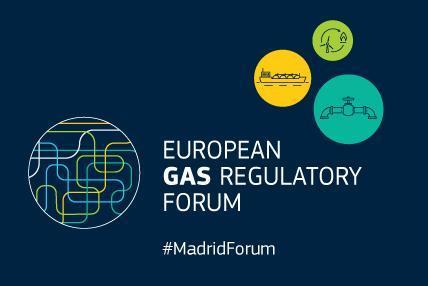A well-functioning and interconnected internal energy market is crucial for maintaining security of energy supply, increasing competitiveness and ensuring that all consumers can purchase energy at affordable prices as well to facilitate energy transition in line with decarbonisation objectives.
To further advance interconnection and boost cross-border trade, in EU's gas networks, the rules, which previously fell under national legislation, have progressed into EU-wide network codes and guidelines.
The European Gas Regulatory Forum (Madrid Forum)

The European Gas Regulatory Forum, also known as the Madrid Forum, gathers key stakeholders across the European energy sector to discuss opportunities and challenges related to the further development and decarbonisation of the internal EU gas market, and to its integration with other energy sectors. It is organised on a yearly basis and the venue is provided by the Spanish energy regulator Comisión Nacional de los Mercados y la Competencia.
The forum participants include national regulatory authorities, EU national governments, the European Commission, transmission system operators, gas suppliers and traders, consumers, network users, and gas exchanges.It was set up in 1999 and has since covered issues like for example competition, market transparency, congestion management and infrastructure development. It has regularly reviewed the progress in developing legislation to harmonise EU energy transmission and trading rules through the gas network codes and their implementation.
The meeting documents are available in a CIRCA BC library, open and accessible to all. The most recent Forum are listed here below
- 38th European Gas Regulatory Forum, on 25-26 April 2024
- 37th European Gas Regulatory Forum, on 11-12 May 2023
How network codes for gas are developed
According to Article 6(1) of the Gas Regulation, the Commission has to establish an 'annual priority list' of areas to be included in the development of network codes, with input from a public consultation. The 2023 consultation was launched on 15 February and closes on 19 April.
On the basis of this, as well as further input from the Agency for the Cooperation of Energy Regulators (ACER) and the European Network of Transmission System Operators for Gas (ENTSOG), the Commission adopts proposals for network codes.
To ensure coherence between the national and the EU level, a gas cross-border committee with specialists from national energy ministers reviews the proposals before the Commission adopts them, with approval from the Council of the European Union and the European Parliament.
In addition, the network codes are being applied, progressively, in the Energy Community, an international organisation that brings together the EU and its neighbours to create an integrated pan-European energy market.
Adopted network codes
The network code on interoperability and data exchange rules coordinates the complex technical procedures used by network operators within the EU and possibly with those used by network operators in the Energy Community and other countries neighbouring the EU.
The network code on gas balancing of transmission networks sets out gas balancing rules, including the responsibilities of transmission system operators and users.
The network code on capacity allocation mechanisms in gas transmission systems requires gas grid operators to use harmonised auctions when selling access to pipelines. These auctions sell the same product at the same time and according to the same rules across the EU.
The Commission's rules on congestion management procedures aim to reduce congestion in gas pipelines. Companies are required to make use of their reserved capacity or risk losing it, while unused capacity should be placed back on the market.
The network code on harmonised transmission tariff structures for gas enhances tariff transparency and coherency by harmonising basic principles and definitions used in tariff calculation, and it includes a mandatory comparison of national tariff-setting methodologies against a benchmark methodology. It also stipulates publication requirements for information on tariffs and revenues of transmission system operators.
Documents
Related links
- Energy Community
- Agency for the Cooperation of Energy Regulators (ACER)
- European Network of Tranmission SYstem Operators for Gas (ENTSOG)
- Decision on the establishment of the 2018 annual priority list for the development of network codes and guidelines (2018/496/EU)
- Regulation establishing a network code on harmonised transmission tariff structures for gas (2017/460/EU)
- Regulation establishing a network code on capacity allocation mechanisms in gas transmission systems and repealing Regulation (2013/984/EU) (2017/459/EU)
- Regulation establishing a network code on interoperability and data exchange rules (2015/703/EU)
- Regulation establishing a network code on gas balancing and transmission networks (2014/312/EU)
- Decision on conditions for access to the natural gas transmission networks (2012/490/EU)
- Regulation on conditions for access to the natural gas transmission networks (715/2009/EC)
